 |
 |
 |
| |
Reasons for not using PrEP in a national on-line sample of U.S. men who have sex with men (MSM) - Cost, Side Effects, Access Lead Reasons for PrEP Nonuse by US MSM
|
| |
| |
Cost, Side Effects, Access Lead Reasons for PrEP Nonuse by US MSM
9th IAS Conference on HIV Science (IAS 2017), July 23-26, 2017, Paris
Mark Mascolini
Factors that kept US men who have sex with men (MSM) from starting preexposure prophylaxis (PrEP) included cost, anticipated side effects, access, insurance concerns, and low perceived risk of HIV infection [1]. But reasons differed between MSM subgroups.
Researchers from Boston's Fenway Health and collaborators noted that more than 400,000 US MSM could benefit from PrEP, according to a CDC estimate. But PrEP use remains low in many MSM communities. To determine reasons for slow PrEP uptake by such men, the researchers conducted a national online survey.
At two popular sex Websites, the investigators invited responses from men 18 or older who reported ever having sex with another man. Survey questions addressed sociodemographics, sexual behavior, PrEP knowledge and use, and reasons for not using PrEP. The investigators used multivariate logistic regression to identify factors independently associated with not using PrEP.
Of the 4968 respondents, 21% were 18 to 24, 18% 25 to 29, 23% 30 to 39, and 38% 40 or older. About half of respondents (48%) were white, 25% were black, 11% Hispanic, and 16% multiracial. Three quarters of respondents (75%) reported having condomless sex twice or more in the past 3 months, while 8% reported condomless sex once in that period and 18% reported no condomless sex. About 17% of respondents ever used PreEP. Among those who did not, only about one quarter never heard of PrEP.
Among 2926 respondents, the most frequent reasons for not using PrEP were concern about costs (40.2%), potential side effects (31.4%), not knowing how to access PrEP (30.6%), potential impact on insurance (19.5%), not feeling at risk (19.3%), and concern about their provider's reaction if asked for PrEP (18.1%). Among 2836 respondents, 15.1% said they were extremely likely to use PrEP in the future, 23.8% likely, 44.5% undecided, 9.8% unlikely, and 6.3% extremely unlikely. Two thirds of respondents (65.3%) said they would not change their frequency of condomless sex if they started PrEP, 30.2% said they would have more condomless sex, and 4.5% said they would have less condomless sex.
Multivariate analysis determined that different factors independently explained nonuse of PrEP in subsets stratified by age, education, country of birth, race/ethnicity, relationship status, and condomless anal sex in the past few months, at the following adjusted odds ratios (aOR) (and 95% confidence intervals). An aOR above 1.0 means the factor favors nonuse of PrEP; an aOR below 1.0 means the factor lowers chances of nonuse.
Age 30-39 vs 18-24:
Side effects: aOR 2.0 (1.4 to 2.8)
Access: aOR 0.7 (0.5 to 0.9)
Age 40+ vs 18-24:
Side effects: aOR 2.3 (1.7 to 3.3)
Access: aOR 0.7 (0.5 to 0.9)
Born outside US vs in US:
Access: aOR 1.4 (1.0 to 1.9)
Black vs white race:
Cost: aOR 0.6 (0.5 to 0.8)
Access: aOR 1.4 (1.0 to 1.7)
Insurance: aOR 0.6 (0.5 to 0.8)
Monogamous relationship:
Cost: aOR 0.7 (0.5 to 0.9)
Side effects: aOR 0.6 (0.4 to 0.9)
No perceived risk: aOR 1.8 (1.2 to 2.6)
Condomless sex once in past 3 months vs none:
Cost: aOR 1.5 (1.1 to 2.0)
Access: aOR 1.4 (1.0 to 1.9)
Condomless sex twice or more in past 3 months vs none:
Cost: aOR 1.3 (1.1 to 1.6)
Access: aOR 1.3 (1.1 to 1.7)
Insurance: aOR 1.3 (1.1 to 1.7)
No perceived risk: aOR 0.5 (0.4 to 0.6)
Compared with men who had a high school education or less, men in four higher education brackets cited cost as a reason for not using PrEP (aORs ranging from 1.4 to 2.1) and side effects as a reason for not using PrEP (aORs ranging from 1.4 to 1.8); but access was unlikely to dissuade more educated men from using PrEP (aORs ranging from 0.5 to 0.7).
In summary, factors that did promote nonuse of PrEP were (1) side effect concerns in men 30 or older and in more educated men, (2) access concerns in blacks, men born outside the US, and men who reported condomless sex in the past 3 months, (3) cost concerns in men who reported condomless sex in the past 3 months and in more educated men, (4) insurance concerns in men who reported condomless sex twice or more in the past 3 months, and (5) lack of perceived HIV risk in monogamous men.
Reference
1. Mayer KH, K. Biello K, Novak DS, Krakower D, Mimiaga MJ. Reasons for not using PrEP in a national on-line sample of U.S. men who have sex with men (MSM). 9th IAS Conference on HIV Science (IAS 2017), July 23-26, 2017, Paris. Abstract MOPEC0648.
-------------------
Reasons for not using PrEP in a national on-line sample of U.S. men who have sex with men (MSM)
K.H. Mayer1,2,3, K. Biello1,4, D.S. Novak5, D. Krakower1,2,3, M.J. Mimiaga1,4
1Fenway Health, The Fenway Institute, Boston, United States, 2Harvard Medical School, Boston, United States, 3Beth Israel Deaconess Medical Center, Boston, United States, 4Brown University, Providence, United States, 5Online Buddies, Inc., Cambridge, United States
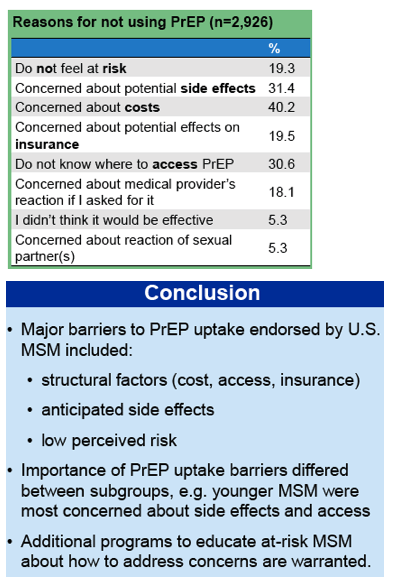
abstract
Background: Although the CDC estimates that >400,000 U.S. MSM could benefit from oral PrEP, many have not initiated it, prompting this analysis
Methods: An on-line survey was mounted on 2 popular MSM sexual networking sites during March 2016 to assess socio-demographics, HIV risk, PrEP knowledge, attitudes and use. Factors independently associated with never using PrEP were evaluated using multivariable logistic regression with backward selection.
Results: Of 4,698 respondents, 21% were 18 to 24 y.o. and 38% were 40 or older. Almost half (47%) were White, 25% Black, 11% Hispanic/Latino, and were from all U.S. states. Almost 12% were born outside the U.S. Nearly 60% had private health insurance; 12% had none. About two-thirds reported condomless anal intercourse (CAI) at least once in the prior 3 months. Most (85%) had not used PrEP previously, with 22% unaware of PrEP. Among 2,926 PrEP-informed non-users, the most common reasons cited for non-use were: concerns about costs (40%), side effects (31%), not knowing where to access PrEP (31%), worries about effects on insurance (20%), and/or not feeling at risk (19.3%). Older MSM were more likely to cite side effects, and less likely to cite access concerns as reasons for non-use. Black MSM were also more likely to cite access concerns, but less likely to cite insurance barriers than other MSM. Less educated MSM were more likely to report access issues but less likely to cite cost, insurance or anticipated side effects, as barriers to using PrEP. MSM born outside of the U.S. were more likely to identify access as a major barrier to PrEP use. MSM who reported monogamous relationships were more likely to report low risk as a reason for PrEP non-use, whereas those who reported more than 2 CAI acts in the prior 3 months, or a history of syphilis, were less likely to cite low risk as a PrEP barrier.
Conclusions: The major barriers to PrEP uptake endorsed by U.S. MSM included structural factors (cost, access, insurance), anticipated side effects, and low perceived risk, and their importance differed between subgroups. Additional programs to educate at-risk MSM about how to address these issues are warranted.
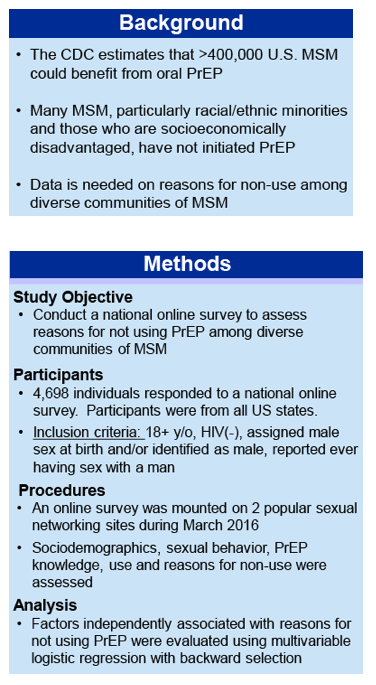
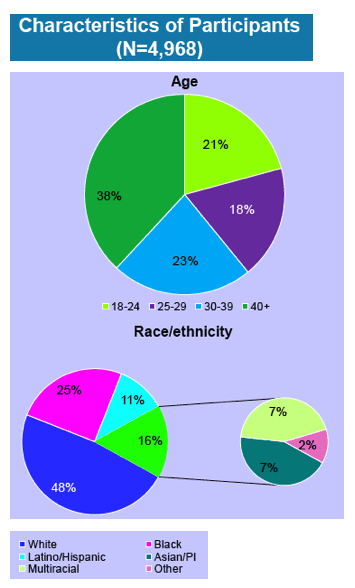
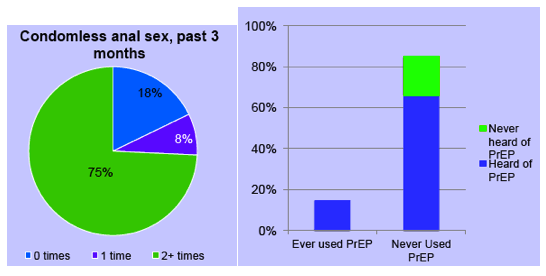
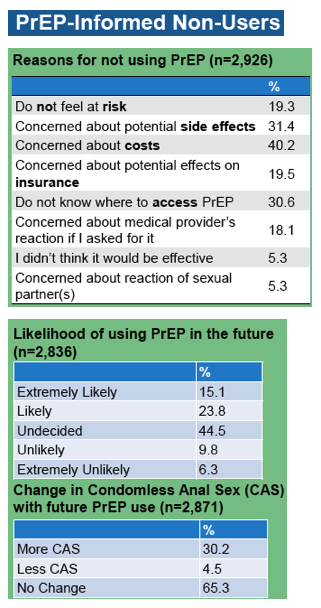
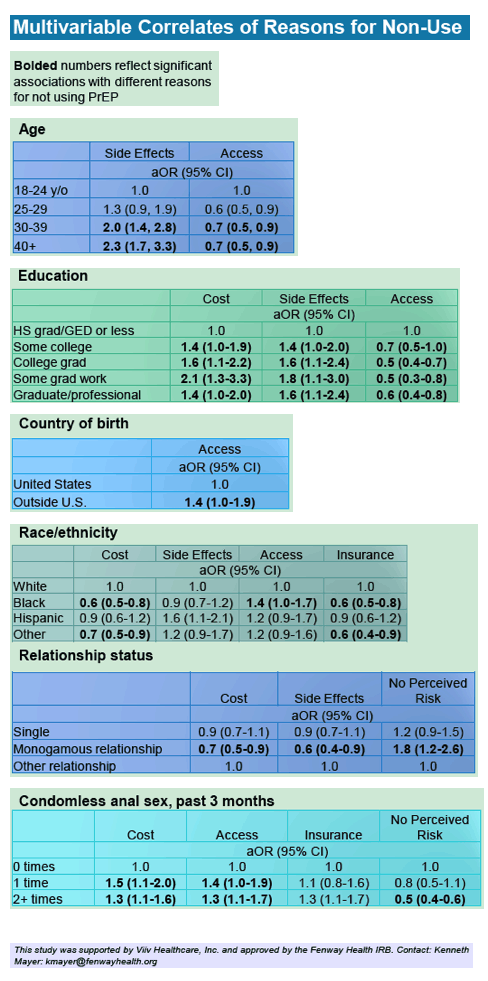
|
| |
|
 |
 |
|
|